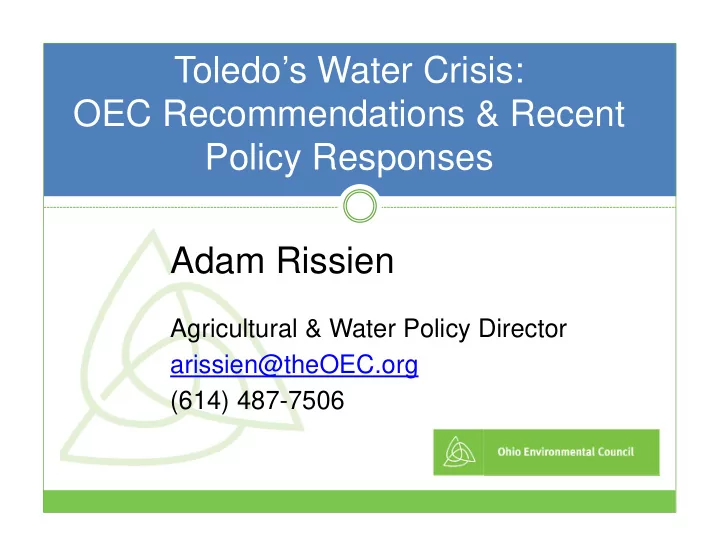

Toledo’s Water Crisis: OEC Recommendations & Recent Policy Responses Adam Rissien Agricultural & Water Policy Director arissien@theOEC.org (614) 487-7506
Ohio Environmental Council Our Mission: To secure healthy air, land, and water for all who call Ohio home.
About the OEC Founded in 1969 Statewide, non-profit, non- government Membership organization – 3,000+ individuals, 100+ group members Budget of $1.5 million – funded primarily by grants & donations Volunteer Board of Directors; 16 staff members
Key Issues Clean Water Program Environmental Health Program Reduce Nutrient Pollution Protecting People from Toxic Prevent Spread of Asian Carp Chemicals Stop Open Lake Disposal Clean Air Program Natural Resources Promoting Renewable Energy Protecting State Parks & Nature Sources Preserves Green Jobs / Green Economy Oil & Gas Drilling Promoting Environmentally Fight Fracking Sustainable Careers
Recent Accomplishments He lped prevent open-lake disposal in Cleveland Supported passage of SB150 for chemical fertilizer certification Helped secure $100 million for Clean Ohio Fund Supported $236 million for state parks in Capital Budget (HB497)
Recent Actions to Reduce Nutrient Pollution Increases in state and federal funding for conservation practices Conservation groups issue Action Agenda Lawmakers introduce key legislation and call for a distressed watershed designation
Funding for Conservation Practices $3 million dollars in new federal emergency funds for the NRCS EQIP program Gov. Kasich reallocated $1.25 million dollars from the Conservation Reserve Enhancement Program US EPA dedicated 7.4 million dollars of Great Lakes Restoration Initiative funding
Conservation Organizations’ Action Agenda We call on all Lake Erie states and the Ontario Province to establish thresholds for the amount of phosphorus allowed into the Lake. Identify the specific amounts of phosphorus flowing into the lake by category of sources
Conservation Organizations’ Action Agenda Ohio has no law prohibiting manure from being applied on frozen or snow covered ground. We call for a state law ending this practice.
Conservation Organizations’ Action Agenda Regulations allow manure to be sold or transferred to other agricultural operations without requiring an approved plan or adequate oversight. The loophole allows uncertified people to apply thousands of tons and millions of gallons of manure. We call for action to CLOSE the MANURE LOOPHOLE
Conservation Organizations’ Action Agenda We call for the Maumee River Watershed to be declared “in distress.” Administered by the Dept. of Natural Resources’ Division of Soil & Water under the Agricultural Pollution Abatement Program.
Distressed Watershed Definition Distressed Watershed is one where aquatic life and health is impaired by nutrients or sediment from agricultural land uses, and where there is a threat to public health, drinking water supplies, recreation, or public safety and welfare.
Distressed Watershed Designation Chief of Soil & Water may designate a watershed to be in distress, triggering requirements: For manure and/or For sediment and For associated nutrient management plans.
Distressed Watershed Designation Regulations only require approved nutrient management plans. Does not mandate any specific best management practice other than prohibiting winter manure application Exempts confined animal feeding facilities operating under a permit.
Nutrient Management Plan Components Regulations direct nutrient management plans address: the methods, amount, form, placement, cropping system; and timing of all nutrient applications.
Introduced State Legislation Senator Edna Brown (D-Toledo) introduced Senate Bill 356 Requires certification for manure application. Requires certification by the end of 2014.
Introduced State Legislation Rep. Michael Sheehy (D-Toledo) introduced House Bill 611 Bans spreading manure on frozen or snow-covered ground.
Ohio Environmental Council
Recommend
More recommend